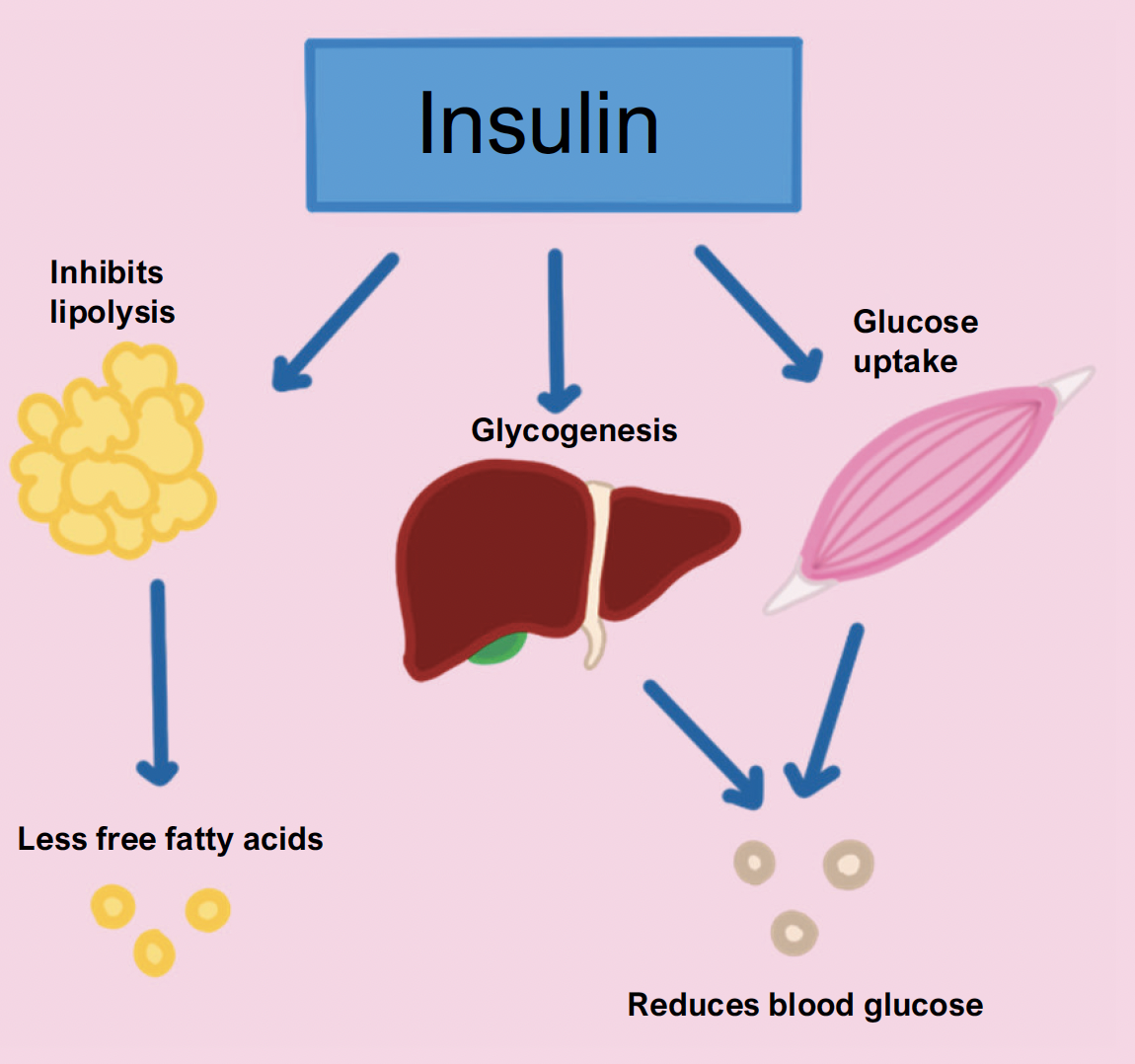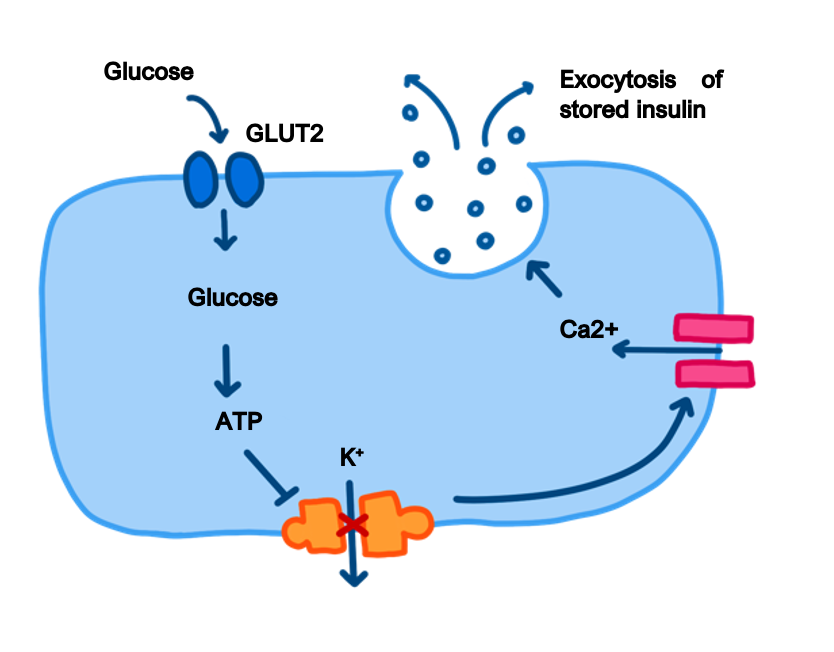Diabetes Medication
Drugs which Reduce blood glucose
Insulins
These are versions of normal insulin which are given by subcutaneous injection.
Insulin is now produced from genetically engineered bacteria.
There are many different forms of insulin, which have different half-lives. These can have immediate and short-lived, or delayed and long-lasting effects on blood sugar.
In addition, mixed preparations which serve both purposes are now also available.
Insulin is prescribed in units and so it is important to use specialised insulin syringes as in normal syringe there are 100 units/mL.

Insulin glulisine/aspart/lispro
These are rapidly acting forms of insulin which are commonly taken after meals
Neutral Protamine Hagedorn (NPH)
This is an intermediate acting form of insulin. It is a suspension of insulin-zinc complexes with protamine which slows absorption.
Insulin detemir/glargine
These are long-acting formulations which have changes to the amino acid sequence which delays absorption
Side effects
Overdose can result in hypoglycemia
Hypokalemia
Weight gain
Lipodystrophy (fat build up) at the injection site
Metformin
This drug reduces gluconeogenesis and increases the peripheral insulin sensitivity.
It also acts to decrease the intestinal absorption of glucose.
It is taken as a tablet, and it is safe to use if breastfeeding.
Metformin does not cause hypoglycaemia or weight gain on its own.
Side effects
Lactic acidosis, higher risk in patients with renal and liver failure
GI upset – if this occurs, gradual uptitrate the dose (e.g., increase each dose every 1–2 weeks) or switch to the modified release tablet
Sulphonylureas
These drugs bind to the SUR1 receptor on KATP channels on the beta-cells closing them, mainly increasing insulin release and also increasing tissue insulin sensitivity. These drugs are very useful in treating type II diabetes but are not effective against type 1 diabetes.

1st generation – Chlorpropamide
This is used in the treatment of Neurogenic diabetes insipidus as it potentiates ADH action at V2 receptors.
However, it is long acting and has highest chance of hypoglycemia, produces SIADH and has disulfiram-like reactions with alcohol.
2nd generation – Glipizide
This is an intermediate acting drug.
3rd generation – Glimepiride
This is a long acting sulphonylurea.
Side effects
Hypoglycaemia, which is proportional to how long the drug acts for
Weight gain
Not used in pregnancy as can cross the placenta
Some can cause SIADH leading to hyponatreamia
People develop tolerance due to downregulation of sulphonylurea receptors
Thiazolidinediones – Pioglitazone, rosiglitazone
These PPAR-y agonists increase tissue sensitivity to insulin and activate the hormone adiponectin.
They reduce plasma glucose but do not cause hypoglycaemia.
They also act on muscle and fat to increase glucose uptake and lipogenesis.
Side effects
Can exacerbate congestive heart failure due to fluid retention
Osteoporosis
Associated with an increased risk of bladder cancer
Weight gain
Incretins – Exenatide, liraglutide
These are synthetic versions of GLP-1, which is produced by stomach cells.
They are taken by subcutaneous injection and result in weight loss.
They also increase insulin secretion and decrease glucagon secretion and appetite.
Side effects
Sickness
Pancreatitis
Also cause weight loss
DPP-4 inhibitors – Sitagliptin, saxagliptin
These inhibit the DPP-4 enzyme which breaks down the incretins GLP-1 and GIP.
Side effects
Indirectly cause sickness
Pancreatitis
Weight loss
SGLTI (selective sodium glucose transporter 2 inhibitor) – Empagliflozin
These are a newer class of drug and they inhibit glucose reabsorption in the kidneys to promote glucose excretion in the urine.
They are very effective but are less used in patients with renal dysfunction.
Side effects
Genital infections
UTI due to increased glucose in urine
Diabetic Ketoacidosis
Alpha-glucosidase inhibitors – Acarbose, miglitol
These inhibit amylase and glucoside enzymes which break down starch in the gut.
Therefore, they act to reduce the absorption of glucose into the bloodstream.
Side effects
Flatulence, their use is avoided in IBD or liver cirrhosis patients
Drugs which increase blood glucose
Glucagon
This is a hormone which is made by the alpha cells of the pancreas.
It promotes gluconeogenesis and glycogenolysis in the liver.
It decreases fatty acid synthesis and promotes lipolysis in liver and adipose tissue.
It is used as a treatment of hypoglycaemic, especially when there is no intravenous access, as it increases the serum glucose concentration.
Associated with minimal side effects.
Diazoxide
This is a potassium channel opener that binds and opens ATP-sensitive K+ channels in the beta-cells causing hyperpolarisation.
The hyperpolarisation of the beta-cells inhibits insulin release.
It can be used to treat hypoglycaemia secondary to an insulinoma.
It is also used as a potent vasodilator used in hypertensive emergency.
Disclaimer




